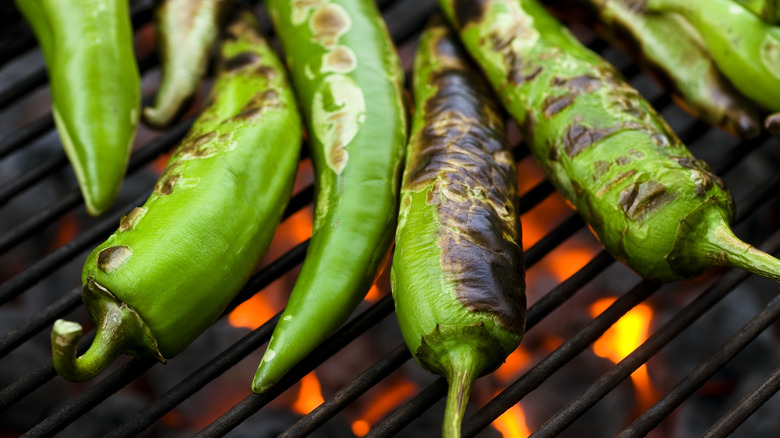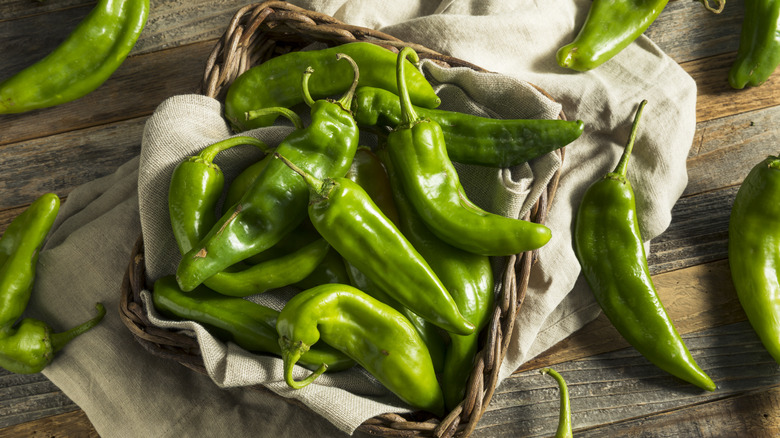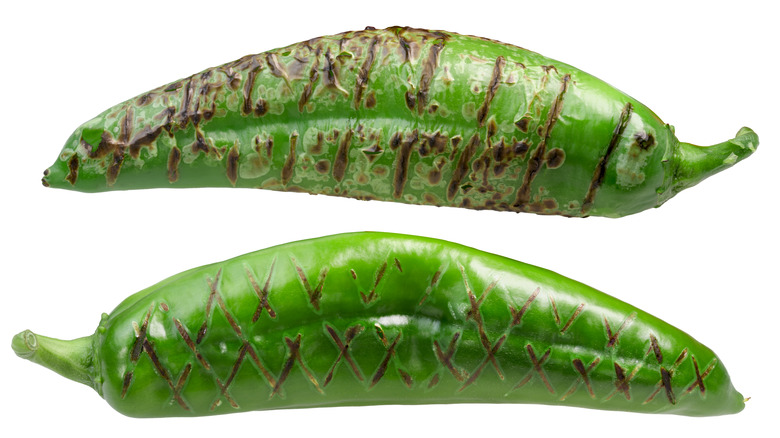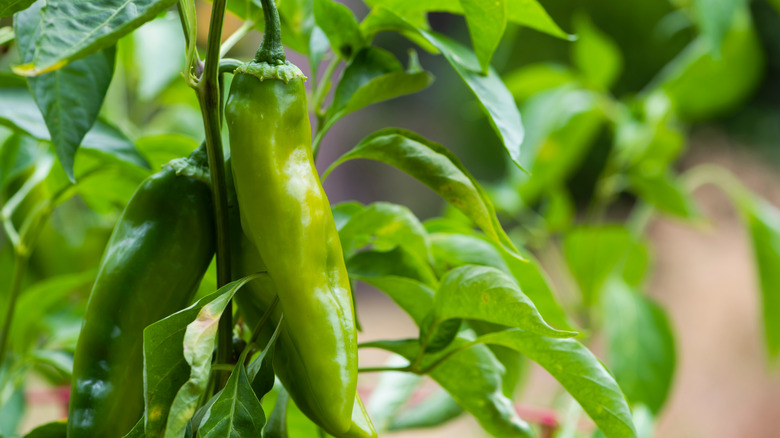What Are Anaheim Peppers And What Do They Taste Like?
Even if you don't like spicy foods, chances are good that you will love Anaheim peppers (scientific name capsicum annuum, via USDA), because though they may resemble a jalapeño or a habanero pepper in appearance, these peppers are on the mild side when it comes to heat. But that doesn't mean they're without flavor: the Anaheim pepper can play a meaningful role in dishes ranging from fajitas to omelets to salsas and more, adding a peppery taste and a pleasant crunch when raw, a smoky and sweet taste when they are cooked, according to Specialty Produce. And they have just enough spice to keep things interesting, too.
Also keeping things interesting, they can be cooked in myriad ways. You can throw Anaheim peppers right on the grill, you can add them to soups or stews, you can stir fry them, and on it goes. As noted, you can also enjoy these peppers raw, whether they are blended into a sauce or salsa or simply bitten into fresh.
While sometimes sold canned or jarred, Anaheim peppers are at their best when fresh whether you are cooking with them or enjoying them raw. They are also relatively easy to grow, so depending on the climate in which you live, you can plant, raise, and harvest your own crop of these mild, versatile, and tasty peppers. From seed to the time they are ready to pick, Anaheim peppers are usually mature within about 80 days, according to Chili Pepper Madness.
But before you devote your time and effort to growing Anaheim peppers yourself, take a minute to learn more about them.
A brief history of the Anaheim pepper
Chili peppers have been used in the cuisine of people native to the Americas for thousands of years, and over the millennia dozens of different varieties of peppers have been developed through cultivation and through the planting of seeds indigenous to one climate in new lands. Rare, however, are cases like that of the Anaheim pepper, a case in which we know the exact provenance of the foodstuff.
According to Chili Pepper Madness, the Anaheim pepper is a cultivar that originated in New Mexico, where it is usually known as the New Mexico chile, the Hatch Chili Pepper, or simply the Hatch pepper. The Anaheim of it all came thanks to a man named Emilio Ortega, who brought the Hatch pepper from New Mexico to the city of Anaheim in Southern California in the year 1894. He began growing and selling these new (to the region, any way) peppers on a commercial scale and they soon became popular thanks to their moderate spice and their pleasant flavor.
How spicy are Anaheim peppers?
Judging how spicy a pepper is can be tricky: yes, there is a scale that rates the actual spice level of a pepper based on its capsaicin content, the Scoville Scale named for Wilbur Scoville, the pharmacologist who developed the measurement system in 1912 (via Alimentarium). For a frame of reference, a standard jalapeño pepper will rate about 5,000 "Average Scoville Heat Units," a cayenne pepper will clock in at 50,000, the habanero usually marked at 150,000, and a Carolina Reaper at 1,500,000, according to Alimentarium. On the milder end of the spectrum, you have the poblano pepper, which rates a 1,250 on the scale, and then bell peppers, which rate a zero.
So how spicy is the Anaheim pepper? According to Chili Pepper Madness, usually it's anywhere between 500 on the low end to as high as 2,500 on the high end, so as mild as a poblano and rarely half as spicy as a jalapeño, in more tangible terms. Or in other words, this is not a very spicy pepper. But it is a delicious pepper, and the spice can be concentrated by drying them out, or made even less pronounced if you remove the seeds from the pepper before cooking with them or eating them raw.
How to cook with an Anaheim pepper
Anything you can do with a jalapeño pepper, you can do with an Anaheim pepper and enjoy a tasty, slightly milder dish. And by the same token, anything you'd do with a banana pepper or a poblano pepper, you can do with an Anaheim for a slightly spicier salsa, sauce, soup, or other foodstuff. But let's get a bit more specific. Anaheim peppers can be sliced and stir fried, they can be chopped and added to simmering soups or stews, they can be grilled, baked, fire roasted, and more. According to Specialty Produce: "The most popular preparation method is to fire roast the pepper until the skin is charred and then remove the skin to reveal tender, flavorful flesh. Once the pepper is cooked, it is chopped into salsas and sauces, served with egg-based dishes, sliced into soups and stews, tossed into pasta, or layered over tacos and nachos."
Popular uses for these semi-spicy peppers include use in cocktails, pairing with cheeses, and as a great visually pleasing (and taste bud satisfying) garnish for salads, soups, loaded potatoes, and more. They can also be sliced open stuffed with ingredients like rice, cheese, and bean blends and baked into a great appetizer or side, and they pair delightfully well with chicken or beef when used in fajitas or similar dishes.
The health benefits of the Anaheim pepper
Don't let their spice fool you into thinking otherwise: chili peppers are quite a healthy food. And besides, not too much spice to worry about on this one, anyway. What you will get plentifully from the Anaheim pepper, according to Speciality Produce, are vitamins A, C, K, and B6. You will also get plenty of fiber, which is great for the digestive system, and potassium, a mineral essential for your body's regulation of fluid balance, for proper nerve and muscle function, and to help prevent potentially serious issues like a stroke, according to Healthline.
According to Pepper Scale, Anaheim peppers are very low in calories, making them a great food to eat when you are managing weight and seeking a healthy lifestyle (and in fact that bit of peppery spice can induce your body to burn extra calories, a double bonus), and they may help your body resist ailments including heart disease, diabetes, and even cancer. Peppers such as the Anaheim may also help lower your LDL cholesterol (the so-called bad cholesterol) levels.




